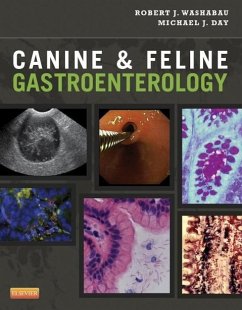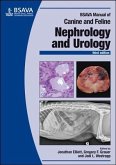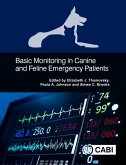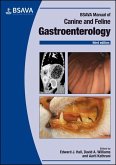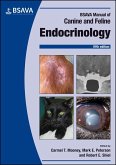Robert J. Washabau (Professor, Department Chairperson, Department o, Michael J. Day (Professor of Veterinary Pathology, Director of Diag
Canine & Feline Gastroenterology
Robert J. Washabau (Professor, Department Chairperson, Department o, Michael J. Day (Professor of Veterinary Pathology, Director of Diag
Canine & Feline Gastroenterology
- Gebundenes Buch
- Merkliste
- Auf die Merkliste
- Bewerten Bewerten
- Teilen
- Produkt teilen
- Produkterinnerung
- Produkterinnerung
Covers the biology, pathobiology, and diagnosis and treatment of diseases of the gastrointestinal, pancreatic, and hepatobiliary systems. This book includes from minor problems such as adverse food reactions to debilitating inflammatory, infectious, metabolic, and neoplastic diseases of the digestive system.
Andere Kunden interessierten sich auch für
![Canine and Feline Behavior, an Issue of Veterinary Clinics of North America: Small Animal Practice Canine and Feline Behavior, an Issue of Veterinary Clinics of North America: Small Animal Practice]() Canine and Feline Behavior, an Issue of Veterinary Clinics of North America: Small Animal Practice106,99 €
Canine and Feline Behavior, an Issue of Veterinary Clinics of North America: Small Animal Practice106,99 €![Canine and Feline Epilepsy Canine and Feline Epilepsy]() Luisa De Risio (UK Animal Health Trust)Canine and Feline Epilepsy81,99 €
Luisa De Risio (UK Animal Health Trust)Canine and Feline Epilepsy81,99 €![BSAVA Manual of Canine and Feline Nephrology and Urology BSAVA Manual of Canine and Feline Nephrology and Urology]() BSAVA Manual of Canine and Feline Nephrology and Urology130,99 €
BSAVA Manual of Canine and Feline Nephrology and Urology130,99 €![Basic Monitoring in Canine and Feline Emergent Patients Basic Monitoring in Canine and Feline Emergent Patients]() Basic Monitoring in Canine and Feline Emergent Patients65,99 €
Basic Monitoring in Canine and Feline Emergent Patients65,99 €![BSAVA Manual of Canine and Feline Gastroenterology BSAVA Manual of Canine and Feline Gastroenterology]() BSAVA Manual of Canine and Feline Gastroenterology123,99 €
BSAVA Manual of Canine and Feline Gastroenterology123,99 €![Normal Cell Morphology in Canine and Feline Cytology Normal Cell Morphology in Canine and Feline Cytology]() Lorenzo ResselNormal Cell Morphology in Canine and Feline Cytology57,99 €
Lorenzo ResselNormal Cell Morphology in Canine and Feline Cytology57,99 €![BSAVA Manual of Canine and Feline Endocrinology BSAVA Manual of Canine and Feline Endocrinology]() BSAVA Manual of Canine and Feline Endocrinology117,99 €
BSAVA Manual of Canine and Feline Endocrinology117,99 €-
-
-
Covers the biology, pathobiology, and diagnosis and treatment of diseases of the gastrointestinal, pancreatic, and hepatobiliary systems. This book includes from minor problems such as adverse food reactions to debilitating inflammatory, infectious, metabolic, and neoplastic diseases of the digestive system.
Hinweis: Dieser Artikel kann nur an eine deutsche Lieferadresse ausgeliefert werden.
Hinweis: Dieser Artikel kann nur an eine deutsche Lieferadresse ausgeliefert werden.
Produktdetails
- Produktdetails
- Verlag: Elsevier Health Sciences
- Seitenzahl: 1024
- Erscheinungstermin: 9. Juli 2012
- Englisch
- Abmessung: 277mm x 226mm x 51mm
- Gewicht: 2942g
- ISBN-13: 9781416036616
- ISBN-10: 141603661X
- Artikelnr.: 35063710
- Herstellerkennzeichnung
- Libri GmbH
- Europaallee 1
- 36244 Bad Hersfeld
- 06621 890
- Verlag: Elsevier Health Sciences
- Seitenzahl: 1024
- Erscheinungstermin: 9. Juli 2012
- Englisch
- Abmessung: 277mm x 226mm x 51mm
- Gewicht: 2942g
- ISBN-13: 9781416036616
- ISBN-10: 141603661X
- Artikelnr.: 35063710
- Herstellerkennzeichnung
- Libri GmbH
- Europaallee 1
- 36244 Bad Hersfeld
- 06621 890
Section I: Biology of the Gastrointestinal Tract, Pancreas, and Liver
1. Integration of Gastrointestinal Function
2. Gastrointestinal Microflora
3. Gastrointestinal Immunology
4. Gastrointestinal Inflammation
5. Cellular Growth/Neoplasia
Section II: Approach to Clinical Signs in Gastrointestinal Disease
6. Abdominal Pain
7. Anorexia
8. Ascites
9. Coagulopathy
10. Constipation
11. Diarrhea
12. Dyschezia and Tenesmus
13. Dysphagia and Gagging
14. Fecal Incontinence
15. Gastrointestinal Gas
16. Hemorrhage (Gastrointestinal)
17. Hepatoencephalopathy
18. Icterus
19. Polyphagia
20. Polyuria/Polydipsia
21. Regurgitation
22. Salivation
23. Vomiting
24. Weight Loss & Cachexia
Section III: Diagnostic Approach to Gastrointestinal, Pancreatic, and
Hepatobiliary Problems
25. Laboratory Approach
26. Diagnostic Imaging of the Gastrointestinal Tract
27. Endoscopy
28. Laparoscopy
29. Histopathology
Section IV: Nutritional Approach to Gastrointestinal Disease
30. Nutritional Assessment and Management
31. Adverse Reactions to Food
32. Nutritional Strategies
33. Enteral and Parenteral Nutrition Section V: Pharmacologic Approach to
Gastrointestinal Disease
34. Antidiarrheal Agents
35. Antiemetic Agents
36. Antifungal Drugs
37. Antihelmintic Agents
38. Antiinflammatory Agents
39. Antimicrobial Agents
40. Antioxidant Drugs
41. Antispasmodic Agents
42. Behavioral Modification
43. Chelating Agents
44. Chemotherapy
45. Cytoprotection - Gastric
46. Cytoprotection - Liver/Biliary
47. Enzyme Supplementation
48. Fluid Therapy
49. Immunosuppressive Drugs
50. Laxative Agents
51. Probiotic Agents
52. Prokinetic Agents
53. Vitamins and Minerals
Section VI: Diseases of the Gastrointestinal Tract
54. Oropharynx
55. Esophagus
56. Stomach
57. Small Intestine
58. Large Intestine
59. Anorectum
60. Pancreas
61. Liver
62. Breed-Relationships
1. Integration of Gastrointestinal Function
2. Gastrointestinal Microflora
3. Gastrointestinal Immunology
4. Gastrointestinal Inflammation
5. Cellular Growth/Neoplasia
Section II: Approach to Clinical Signs in Gastrointestinal Disease
6. Abdominal Pain
7. Anorexia
8. Ascites
9. Coagulopathy
10. Constipation
11. Diarrhea
12. Dyschezia and Tenesmus
13. Dysphagia and Gagging
14. Fecal Incontinence
15. Gastrointestinal Gas
16. Hemorrhage (Gastrointestinal)
17. Hepatoencephalopathy
18. Icterus
19. Polyphagia
20. Polyuria/Polydipsia
21. Regurgitation
22. Salivation
23. Vomiting
24. Weight Loss & Cachexia
Section III: Diagnostic Approach to Gastrointestinal, Pancreatic, and
Hepatobiliary Problems
25. Laboratory Approach
26. Diagnostic Imaging of the Gastrointestinal Tract
27. Endoscopy
28. Laparoscopy
29. Histopathology
Section IV: Nutritional Approach to Gastrointestinal Disease
30. Nutritional Assessment and Management
31. Adverse Reactions to Food
32. Nutritional Strategies
33. Enteral and Parenteral Nutrition Section V: Pharmacologic Approach to
Gastrointestinal Disease
34. Antidiarrheal Agents
35. Antiemetic Agents
36. Antifungal Drugs
37. Antihelmintic Agents
38. Antiinflammatory Agents
39. Antimicrobial Agents
40. Antioxidant Drugs
41. Antispasmodic Agents
42. Behavioral Modification
43. Chelating Agents
44. Chemotherapy
45. Cytoprotection - Gastric
46. Cytoprotection - Liver/Biliary
47. Enzyme Supplementation
48. Fluid Therapy
49. Immunosuppressive Drugs
50. Laxative Agents
51. Probiotic Agents
52. Prokinetic Agents
53. Vitamins and Minerals
Section VI: Diseases of the Gastrointestinal Tract
54. Oropharynx
55. Esophagus
56. Stomach
57. Small Intestine
58. Large Intestine
59. Anorectum
60. Pancreas
61. Liver
62. Breed-Relationships
Section I: Biology of the Gastrointestinal Tract, Pancreas, and Liver
1. Integration of Gastrointestinal Function
2. Gastrointestinal Microflora
3. Gastrointestinal Immunology
4. Gastrointestinal Inflammation
5. Cellular Growth/Neoplasia
Section II: Approach to Clinical Signs in Gastrointestinal Disease
6. Abdominal Pain
7. Anorexia
8. Ascites
9. Coagulopathy
10. Constipation
11. Diarrhea
12. Dyschezia and Tenesmus
13. Dysphagia and Gagging
14. Fecal Incontinence
15. Gastrointestinal Gas
16. Hemorrhage (Gastrointestinal)
17. Hepatoencephalopathy
18. Icterus
19. Polyphagia
20. Polyuria/Polydipsia
21. Regurgitation
22. Salivation
23. Vomiting
24. Weight Loss & Cachexia
Section III: Diagnostic Approach to Gastrointestinal, Pancreatic, and
Hepatobiliary Problems
25. Laboratory Approach
26. Diagnostic Imaging of the Gastrointestinal Tract
27. Endoscopy
28. Laparoscopy
29. Histopathology
Section IV: Nutritional Approach to Gastrointestinal Disease
30. Nutritional Assessment and Management
31. Adverse Reactions to Food
32. Nutritional Strategies
33. Enteral and Parenteral Nutrition Section V: Pharmacologic Approach to
Gastrointestinal Disease
34. Antidiarrheal Agents
35. Antiemetic Agents
36. Antifungal Drugs
37. Antihelmintic Agents
38. Antiinflammatory Agents
39. Antimicrobial Agents
40. Antioxidant Drugs
41. Antispasmodic Agents
42. Behavioral Modification
43. Chelating Agents
44. Chemotherapy
45. Cytoprotection - Gastric
46. Cytoprotection - Liver/Biliary
47. Enzyme Supplementation
48. Fluid Therapy
49. Immunosuppressive Drugs
50. Laxative Agents
51. Probiotic Agents
52. Prokinetic Agents
53. Vitamins and Minerals
Section VI: Diseases of the Gastrointestinal Tract
54. Oropharynx
55. Esophagus
56. Stomach
57. Small Intestine
58. Large Intestine
59. Anorectum
60. Pancreas
61. Liver
62. Breed-Relationships
1. Integration of Gastrointestinal Function
2. Gastrointestinal Microflora
3. Gastrointestinal Immunology
4. Gastrointestinal Inflammation
5. Cellular Growth/Neoplasia
Section II: Approach to Clinical Signs in Gastrointestinal Disease
6. Abdominal Pain
7. Anorexia
8. Ascites
9. Coagulopathy
10. Constipation
11. Diarrhea
12. Dyschezia and Tenesmus
13. Dysphagia and Gagging
14. Fecal Incontinence
15. Gastrointestinal Gas
16. Hemorrhage (Gastrointestinal)
17. Hepatoencephalopathy
18. Icterus
19. Polyphagia
20. Polyuria/Polydipsia
21. Regurgitation
22. Salivation
23. Vomiting
24. Weight Loss & Cachexia
Section III: Diagnostic Approach to Gastrointestinal, Pancreatic, and
Hepatobiliary Problems
25. Laboratory Approach
26. Diagnostic Imaging of the Gastrointestinal Tract
27. Endoscopy
28. Laparoscopy
29. Histopathology
Section IV: Nutritional Approach to Gastrointestinal Disease
30. Nutritional Assessment and Management
31. Adverse Reactions to Food
32. Nutritional Strategies
33. Enteral and Parenteral Nutrition Section V: Pharmacologic Approach to
Gastrointestinal Disease
34. Antidiarrheal Agents
35. Antiemetic Agents
36. Antifungal Drugs
37. Antihelmintic Agents
38. Antiinflammatory Agents
39. Antimicrobial Agents
40. Antioxidant Drugs
41. Antispasmodic Agents
42. Behavioral Modification
43. Chelating Agents
44. Chemotherapy
45. Cytoprotection - Gastric
46. Cytoprotection - Liver/Biliary
47. Enzyme Supplementation
48. Fluid Therapy
49. Immunosuppressive Drugs
50. Laxative Agents
51. Probiotic Agents
52. Prokinetic Agents
53. Vitamins and Minerals
Section VI: Diseases of the Gastrointestinal Tract
54. Oropharynx
55. Esophagus
56. Stomach
57. Small Intestine
58. Large Intestine
59. Anorectum
60. Pancreas
61. Liver
62. Breed-Relationships

